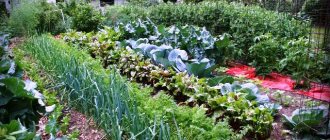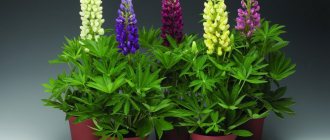Any novice summer resident is interested in the question of what to plant in the garden. After all, there are a lot of crops grown in our country. In addition, it is not enough to simply plant and grow all the vegetables and herbs in a row. It is also necessary to take into account some nuances, for example, the correct “neighborhood” of plants. It is also important to know where exactly a particular crop should be planted on the site, because some plants require light places, while others require shade. If a gardener knows all the nuances of planting plants in summer cottage beds, he will receive a beautiful plot (and flowers will perfectly decorate his landscape design) and a good harvest.
- We are planning landings
- Optimal bed sizes
- What to grow in the garden
- Seating table
- What crops can be combined with each other in the garden?
- Flowers in the country garden
- Decorative vegetable garden
We are planning landings
- Draw a plan of your site on graph paper, to scale. Format no smaller than A3. No need to sketch by hand on your knee, take accurate measurements. You will need a tape measure and an assistant.
- Mark on the site diagram all existing and planned buildings: house, barn, utility rooms, swings, gazebos, barbecue area or pool, all flower beds, compost heap. We separately note the vineyard (if there is one or planned).
- Make a copy of the site plan, for example, on tracing paper or redraw it, photocopy it, as there may be several options.
- In the entire space free from buildings and flower beds, select zones based on illumination: the sunniest places and the shady ones. To do this, take a day and look carefully at where the shadows of trees and buildings fall.
- Mark the water source.
- Choose places where you can put greenhouses or a greenhouse - these are the widest areas. Consider the distance between paths and rows. The passage for a wheelbarrow should be at least 50-60 cm; the larger the area, the greater the width of the paths you can afford. But if the plot is small, it all depends on your appetite: are you ready to make do with 30-centimeter passages between the beds or do you need more to turn around while weeding.
- If you have made a large list of planned plantings in the garden, it is better to make more narrow beds of 45-60 cm than wide meter beds.
Front area
Such territory is present on any site. They pay special attention to her, as she is always in sight. Think in advance about the location of drains and collectors into which rainwater will flow.
To decorate the entrance, decorative plants are placed along the fence. They provide a platform for cars to enter and a path leading to the house. They are combined or separated using a flower garden.
Optimal bed sizes
The beds need to be planned in such a size that they are easy to care for: sowing, planting seedlings, weeding and reaching with a watering can.
Therefore, the ideal dimensions are width 80 cm, length 3-4 m, height 35 cm (for beds with a fence). If you have a lot of children’s helpers, for example, during the holidays, grandchildren and children help with weeding, then the best width is 70 cm.
With such dimensions, it is convenient for everyone to reach with their hand from each side of the row spacing to the middle of the bed.
The maximum permissible width of the bed is 1 m, for cabbage, which is planted in two rows, 100-120 cm can be allocated. The width of the rows is at least 30 cm, optimally 40 cm, if a wheelbarrow needs to drive up to the bed, then 50 cm. These dimensions are for a small vegetable garden , where every centimeter is precious. If your area is quite large, feel free to leave passages 60-80 cm wide.
Screens and arches for zoning
Plants help make an area beautiful. Screens and arches entwined with perennials will protect the recreation area from the wind and prying eyes. If you plant grapes, you can not only get an excellent hedge, but also reap a good harvest.
Supports are selected according to the size of the plants. Using an arch entwined with flowers, they decorate the central gate to the garden, a gate, and a children's playground.
What to grow in the garden
Now we have come to the moment when the beds are laid out, it’s time to decide what to plant. We compose the wishes of family members and look at the list:
- Tomatoes
- Eggplant
- Bell pepper and hot pepper
- Cucumbers for canning and salad
- Beet
- Carrot
- Onions for the winter and for canning
- White cabbage early, middle, late,
- Cauliflower
- Kohlrabi
- Radish,
- Turnip
- Daikon
- Garlic
- Zucchini
- Patissons
- Pumpkin
- Beans
- Leaf lettuce
- Head lettuce
- Dill
- Parsley
- Watermelon
- Peas
- Corn
- Early potatoes
- Strawberries
- Strawberry
- Raspberries
Yes, the list is long... What to do? But now we need to cross out the excess. To begin with, let’s make a reservation that we grow not for sale, but for ourselves. A commercial vegetable garden is a completely different matter.
Therefore, if the garden area and planned beds are clearly not enough for the desired list, you need to cross out the excess according to the principle of expediency and profitability of cultivation.
For example, potatoes - to provide a family with potatoes for the winter, you need not a vegetable garden, but a separate potato field or plot. But it is quite possible to grow early potatoes, at a time when they are extremely expensive in stores, but in the basement they are already soft and sprouted. At the same time, you only need to plant a dozen bushes to provide a family of 3-4 people with potatoes for a month (relatively speaking).
Cross off the entire list of desired vegetables and berries according to the principle that is more convenient for you personally:
- which are the hardest to grow
- which are the cheapest in the market or in a store (easier to buy)
- that require more time than you can give them
- which are more difficult to provide with the required temperature, light and water
- which are incompatible with other crops that you really need
The yield of certain garden crops is very different; some occupy a large area but produce a small harvest, for example, peas. Its yield greatly depends on the variety, it takes up a lot of space, and by and large, not everyone produces good peas.
Or corn - it occupies a decent area, the yield does not justify it if the area is small. In addition, few people like corn as a vegetable - grapes and beets do not tolerate it.
But radishes are an undemanding and very profitable crop. Early vegetables are always very expensive, but the most desirable, and such as radishes, combined with many vegetables and berries, are very justified. The same applies to lettuce and basil. Dill does not need to be specially grown at all - it perfectly fills areas of the garden with self-sowing, where it is convenient for it.
If you have a small child who is prone to allergies or for some reason is forced to make do with dietary food, you may need to give up certain crops, for example, spices, legumes (except green manure), daikon and allergenic berries, but allocate a sunny bed for watermelons , melons or more beds planted with cauliflower.
Or take a vegetable like eggplant - it’s not difficult to grow it, you can also find a place in the garden, and it’s more profitable to grow it than to buy it - the prices for eggplant are high all year round, and the vegetable is used in many snacks and pickles.
And yet, the main criterion that determines what to plant at the dacha remains climatic conditions, because it is simply not possible to force a plant that requires a lot of light to bear fruit in the shade. Even if you want, you cannot grow watermelons if the area is not sunny and warm.
Outbuildings and recreation area
It is necessary to take care of the arrangement of the economic part, which includes a greenhouse, sheds, a bathhouse, and a garage. Paved paths are suitable for this area. If you can’t hide this part, then it can be easily decorated with different plants.
A comfortable recreation area can be provided on the site. It usually includes a barbecue, a track, and a gazebo. It is installed near the house to provide easy access to the building during feasts and family tea parties.
Seating table
| Vegetable name | When to plant | How to plant | When to Harvest |
| Sorrel | Late April - early May | Seeds are sown to a depth of 2 cm, row spacing is 25 cm. To speed up the appearance of sunrises, the seeds must be kept in a damp cloth for 2-3 days before sowing. | 2 months later |
| Spinach | From March to May | Sowing is carried out with individual seeds in furrows to a depth of 1.5-2 cm, row spacing 30 cm. | After 8-10 weeks, late varieties after 12. |
| Garlic | Garlic is planted before winter and early spring. | Most often propagated by teeth. When planting before winter, plant to a depth of 5-8 cm. In spring, to a depth of 3-4 cm with two or three line ribbons. The distance between lines is 12-15 cm, between ribbons - 50, between plants - 5-8 cm. | In July–August, when the leaves dry out and dry filmy leaves form on the bulb. |
| Beans | May June | Seeds are soaked overnight before planting. Sow with two-line tapes: 20-30 cm between lines, 50 cm between tapes, 7.5-10 cm in a row, or 45-60 cm in single-line rows. Seed placement depth is 2 cm on dense soils, 5 cm on loose soils. | 8-12 weeks after emergence. |
| Dill | April | To obtain early shoots, the seeds are soaked in water for 2-3 days (the water is changed 3 times a day) and then dried. Dill is sown on a flat surface, to a depth of 1.5 cm, with a distance between rows of 15-20 cm. | 30-40 days after sowing. |
| Pumpkin | In March-April for seedlings. Into the ground in May. | The seeds need to be germinated. First, seedlings are planted, which are then planted in open ground. | Early ripening varieties after 90-100 days from germination, late ripening after 110-130 days. |
| Tomato | For seedlings in early March. In the ground at the end of May. | Usually planted through seedlings. 50-60 day old seedlings are planted in open ground. Tomatoes are planted on beds, ridges or flat surfaces. The roots are covered with soil up to the cotyledon leaves. Strongly elongated plants are placed obliquely, with their apex to the south, immersed in the soil by 1/4 or 1/3 of its height, leaving a part of the stem with leaves 20-25 cm high above the surface. The lower inflorescence should remain above the soil surface. | 90-125 days after germination. |
| Beet | May | To speed up germination, seeds are soaked in warm water 2-3 days before sowing. The seeds are placed in grooves made at a distance of 15-20 cm from each other. | In September - early October, before the onset of severe frosts. |
| Radish | Early April | Sow in furrows, with a distance in rows of 8-10 cm, to a depth of 1.5-2 cm. | Early ripening varieties after 18-21 days from full germination, late ripening after 40-45. |
| Parsley | Late April, late June – early July, late October, early November | When sowing in spring, parsley seeds are sown to a depth of 2-2.5 cm. Summer sowing is carried out with soaked seeds on well-moistened soil. | After 60-70 days from germination. |
| Pepper | For seedlings in February - early March. Into the ground at the end of May – beginning of June. | The seeds are soaked for 2 days. Then they are planted for seedlings. 60-day-old seedlings are transplanted into open ground. | The fruits are picked selectively, not simultaneously. Some sweet varieties ripen as early as August. |
| Cucumber | May | Before sowing, the seeds are soaked for 12 hours. Sow the seeds in lines, to a depth of 2-2.5 cm, a distance of 8-10 cm in a line, 50-70 cm between lines. | 45-50 days from sunrise. |
| Carrot | In the second half of April | To get early shoots, the seeds are soaked for 1-2 days, then kept wet for a week until they sprout. On beds 1 m wide, four rows of carrots are placed with row spacing of 28-30 cm. | Early varieties ripen in 60-80 days, late varieties in 80-115 days. |
| Corn | End of April - May | Seeds are sown in rows with a distance between them of 70 cm and 25-30 cm between plants, sowing depth - 6-8 cm | Early varieties ripen in 60-70 days, late varieties - 102-105 days. |
| Potato | May | Propagated by germinated tubers. The optimal planting depth on light soils is 10-12 cm, on medium loamy and heavy soils - 8-10 cm, the distance between tubers is 25 - 30 cm. Row spacing is 60-70 cm. | Early ripening varieties ripen in mid-July. Mid-season and late varieties - in August-September or in the first half of October. |
| Cauliflower | From March 15 to March 30, then at intervals of two weeks until the end of May - sowing seeds. From April 25 to May 10, then at intervals of two weeks until June 10 - planting in open ground. | It is preferable to plant through seedlings. Seedlings are planted in open ground 6-7 weeks after emergence, over several periods. Seedlings are planted in a bed in 2 rows, the distance in a row is 30-40 cm, between rows 50-55 cm. Planting depth is according to the first true leaf. Seedless method - 3-5 seeds are sown per hole, excess seedlings are pulled out or planted. | Early ripening varieties after 85-90 days from germination, late ripening varieties after 120-130 days. |
| Chinese cabbage | Under film - early April, in open ground - late April-early May. | Plant either through seedlings or by sowing seeds in the ground. When sowing seeds in open ground, they are placed on ridges in 3 rows with row spacing of 35-40 cm. They are sown in nests every 35-40 cm. 4-5 seeds are planted in each nest. After germination, thin out, leaving two and then one of the most developed plants. | Cabbage planted under film can be harvested as early as June. |
| Brussels sprouts | For seedlings in March-April. Into the ground in May-June. | Planted through seedlings. Cabbage should be planted at a distance of 90 cm from each other, so that its lower leaves are above the soil level. After the plants are transplanted, they need to be watered well. | September October |
| White cabbage | End of April - May. | Planted through seedlings. After 50-60 days, the seedlings are transplanted into open ground. | Ripens in 100-170 days (depending on the variety). |
| Zucchini | For seedlings at the end of April. Into the ground at the end of May - beginning of June. | It is grown by seedlings and without seedlings. Seedlings are planted in the ground after 20-25 days. Seeds are soaked for 3 days before sowing. The depth of seed placement on light soils is 5-6 cm, and on heavy soils 3-4 cm. | In 60-70 days. |
| Peas | End of April, then at intervals of two weeks until the beginning of July. | The seeds can be soaked, or they can be planted dry. Using a flat hoe, make a furrow 15-25 cm wide along the beds. Scatter the peas at a distance of 5-8 cm from each other over the entire area of the furrow. Next, sprinkle them with earth from the sides so that the peas are at a depth of no more than 5 cm and be sure to compact the earth on top with the back of the rake. | After 7-14 weeks (depending on the variety). |
| Celery root | For seedlings in early March. In the ground at the end of May. | Plants through seedlings. The seeds are soaked before planting. The peculiarity of celery seeds is that they cannot be sprinkled heavily with soil; they must be on the surface, in bright light. After 60 days, the seedlings are planted in open ground. Most often, celery is planted in beds with a distance between rows of 65 cm, between plants in a row of 20 cm. Early ripening varieties are grown according to a 40x40 cm pattern; three rows of plants can be placed in a regular bed. Mid-season celery varieties are planted according to the 50-60x20-30 cm pattern. | In 170-180 days. |
Zoning by height difference
By raising part of the area, you can get an interesting effect. A practical option would be a wooden deck near the pool. Residents of a country house will find it convenient to relax in a place separated by a raised flower bed or wall.
If you make a small garden lower than the rest of the territory, in which you create an artificial pond, you can create a special microclimate. This zone will be cooler in the heat, plants grow well in a humid place.
What crops can be combined with each other in the garden?
Before planting crops, it is necessary to familiarize yourself with information regarding crop compatibility. Below is a list of the main crops and plants that can be combined and which are best planted at a distance from each other.
Cucumbers. This vegetable goes well with:
- salad,
- radish,
- sunflower,
- corn,
- tomatoes,
- peas.
Cucumbers have poor compatibility with:
- sage
- fennel,
- dill,
- mint.
Tomatoes. Adjacent to:
- garlic,
- carrots,
- spinach,
- onions,
- corn,
- cabbage,
- parsley
It is better not to plant next to tomatoes:
- potatoes,
- beets,
- fennel.
You can sow next to cabbage
- beets,
- potatoes,
- beans,
- mint,
- dill.
These vegetables do not go well with:
- tomatoes,
- strawberries.
Eggplants can be planted near any vegetables (for example, cauliflower), but the best neighbors are:
- legumes,
- aromatic herbs.
Potatoes prefer proximity to:
- cabbage,
- radish,
- corn,
- beans,
- salad.
You should not plant next to potatoes:
- tomatoes,
- pumpkin,
- cucumbers
Carrots go well with:
- onions,
- tomatoes,
- sage
- garlic,
- beans,
- radish.
But it is not advisable to combine dill with carrots.
The bow is compatible with:
- cabbage,
- carrots,
- beets,
- salad,
- radish,
- strawberries.
Bad neighbors are:
- beans,
- peas.
Combine pepper
- basil,
- coriander,
- carrots,
- onions
It is advisable to exclude from:
- fennel,
- beans.
Radishes react calmly to proximity to any vegetables.
Salad. Will be a good neighbor for:
- wild strawberries (strawberries),
- beets,
- peas,
- tomatoes,
- cabbage
Salad does not get along well with parsley, but it does well with chrysanthemums.
Beet. It has good compatibility with cabbage, but does not go well with tomatoes and beans.
Beans. Develops normally, adjacent to:
- cabbage,
- beets,
- tomatoes,
- pumpkin,
- carrots.
Doesn't go well with:
- leeks,
- garlic
Garlic , if possible, grows well next to gladioli.
Dividing territory using color
Visual zoning is carried out by planting plants of a certain shade. Red, yellow and orange flowers give vigor and lift your spirits. The composition is supplemented with coniferous plants.
Yellow, orange and blue crops are suitable for the playground. They will attract the attention of little fidgets. Pastel colors are chosen for the recreation area, which will help you relax and gain strength while admiring the beauty of nature.
Shape of the plot
It can be either traditional rectangular or very different, for example, triangular or with rounded corners.
Start
Never try to do everything at once. Don’t be afraid to start small - a successful start will give you confidence in your abilities and increase motivation for further work.
In the first year of gardening, we recommend planting radishes, cucumbers, onions, and sowing lettuce seeds. It seems like a simple set, but it’s quite enough for preparing salads, and it won’t take a lot of time and effort to work in the garden.
Advice! Don't try to grow tomatoes and strawberries the first year! These are capricious crops that require careful care and certain skills.
Using cardinal directions
Allows you to choose the right plants, because... Most garden crops require a lot of light.
A properly designed site layout will allow you to compactly arrange the beds, fruit trees and shrubs so that there is enough space for everyone.











